Fangxin Shang
Towards a Multimodal Large Language Model with Pixel-Level Insight for Biomedicine
Dec 12, 2024Abstract:In recent years, Multimodal Large Language Models (MLLM) have achieved notable advancements, demonstrating the feasibility of developing an intelligent biomedical assistant. However, current biomedical MLLMs predominantly focus on image-level understanding and restrict interactions to textual commands, thus limiting their capability boundaries and the flexibility of usage. In this paper, we introduce a novel end-to-end multimodal large language model for the biomedical domain, named MedPLIB, which possesses pixel-level understanding. Excitingly, it supports visual question answering (VQA), arbitrary pixel-level prompts (points, bounding boxes, and free-form shapes), and pixel-level grounding. We propose a novel Mixture-of-Experts (MoE) multi-stage training strategy, which divides MoE into separate training phases for a visual-language expert model and a pixel-grounding expert model, followed by fine-tuning using MoE. This strategy effectively coordinates multitask learning while maintaining the computational cost at inference equivalent to that of a single expert model. To advance the research of biomedical MLLMs, we introduce the Medical Complex Vision Question Answering Dataset (MeCoVQA), which comprises an array of 8 modalities for complex medical imaging question answering and image region understanding. Experimental results indicate that MedPLIB has achieved state-of-the-art outcomes across multiple medical visual language tasks. More importantly, in zero-shot evaluations for the pixel grounding task, MedPLIB leads the best small and large models by margins of 19.7 and 15.6 respectively on the mDice metric. The codes, data, and model checkpoints will be made publicly available at https://github.com/ShawnHuang497/MedPLIB.
A Refer-and-Ground Multimodal Large Language Model for Biomedicine
Jun 26, 2024Abstract:With the rapid development of multimodal large language models (MLLMs), especially their capabilities in visual chat through refer and ground functionalities, their significance is increasingly recognized. However, the biomedical field currently exhibits a substantial gap in this area, primarily due to the absence of a dedicated refer and ground dataset for biomedical images. To address this challenge, we devised the Med-GRIT-270k dataset. It comprises 270k question-and-answer pairs and spans eight distinct medical imaging modalities. Most importantly, it is the first dedicated to the biomedical domain and integrating refer and ground conversations. The key idea is to sample large-scale biomedical image-mask pairs from medical segmentation datasets and generate instruction datasets from text using chatGPT. Additionally, we introduce a Refer-and-Ground Multimodal Large Language Model for Biomedicine (BiRD) by using this dataset and multi-task instruction learning. Extensive experiments have corroborated the efficacy of the Med-GRIT-270k dataset and the multi-modal, fine-grained interactive capabilities of the BiRD model. This holds significant reference value for the exploration and development of intelligent biomedical assistants.
SegICL: A Universal In-context Learning Framework for Enhanced Segmentation in Medical Imaging
Apr 02, 2024Abstract:Medical image segmentation models adapting to new tasks in a training-free manner through in-context learning is an exciting advancement. Universal segmentation models aim to generalize across the diverse modality of medical images, yet their effectiveness often diminishes when applied to out-of-distribution (OOD) data modalities and tasks, requiring intricate fine-tuning of model for optimal performance. For addressing this challenge, we introduce SegICL, a novel approach leveraging In-Context Learning (ICL) for image segmentation. Unlike existing methods, SegICL has the capability to employ text-guided segmentation and conduct in-context learning with a small set of image-mask pairs, eliminating the need for training the model from scratch or fine-tuning for OOD tasks (including OOD modality and dataset). Extensive experimental validation of SegICL demonstrates a positive correlation between the number of prompt samples and segmentation performance on OOD modalities and tasks. This indicates that SegICL effectively address new segmentation tasks based on contextual information. Additionally, SegICL also exhibits comparable segmentation performance to mainstream models on OOD and in-distribution tasks. Our code will be released soon.
SynFundus: Generating a synthetic fundus images dataset with millions of samples and multi-disease annotations
Dec 01, 2023Abstract:In the field of medical imaging, the scarcity of large-scale datasets due to privacy restrictions stands as a significant barrier to develop large models for medical. To address this issue, we introduce SynFundus-1M, a high-quality synthetic dataset with over 1 million retinal fundus images and extensive disease and pathologies annotations, which is generated by a Denoising Diffusion Probabilistic Model. The SynFundus-Generator and SynFundus-1M achieve superior Frechet Inception Distance (FID) scores compared to existing methods on main-stream public real datasets. Furthermore, the ophthalmologists evaluation validate the difficulty in discerning these synthetic images from real ones, confirming the SynFundus-1M's authenticity. Through extensive experiments, we demonstrate that both CNN and ViT can benifit from SynFundus-1M by pretraining or training directly. Compared to datasets like ImageNet or EyePACS, models train on SynFundus-1M not only achieve better performance but also faster convergence on various downstream tasks.
SeATrans: Learning Segmentation-Assisted diagnosis model via Transformer
Jun 22, 2022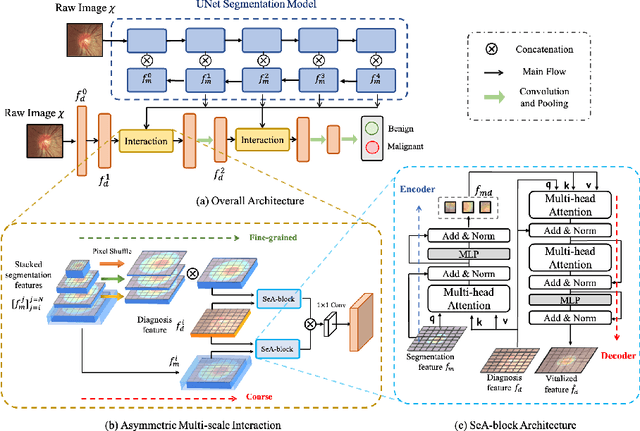
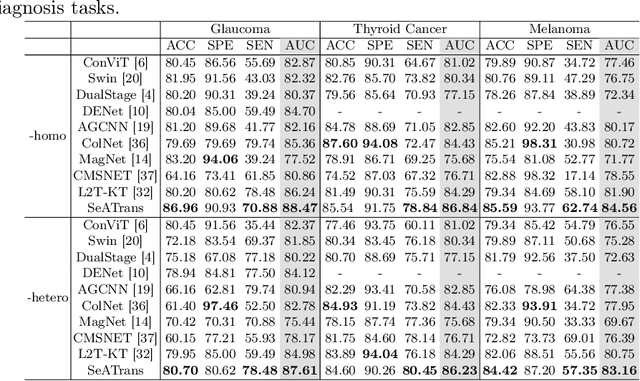
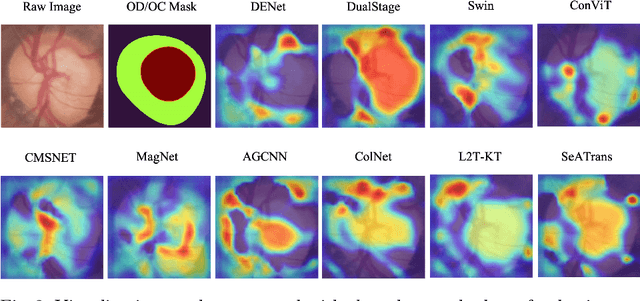

Abstract:Clinically, the accurate annotation of lesions/tissues can significantly facilitate the disease diagnosis. For example, the segmentation of optic disc/cup (OD/OC) on fundus image would facilitate the glaucoma diagnosis, the segmentation of skin lesions on dermoscopic images is helpful to the melanoma diagnosis, etc. With the advancement of deep learning techniques, a wide range of methods proved the lesions/tissues segmentation can also facilitate the automated disease diagnosis models. However, existing methods are limited in the sense that they can only capture static regional correlations in the images. Inspired by the global and dynamic nature of Vision Transformer, in this paper, we propose Segmentation-Assisted diagnosis Transformer (SeATrans) to transfer the segmentation knowledge to the disease diagnosis network. Specifically, we first propose an asymmetric multi-scale interaction strategy to correlate each single low-level diagnosis feature with multi-scale segmentation features. Then, an effective strategy called SeA-block is adopted to vitalize diagnosis feature via correlated segmentation features. To model the segmentation-diagnosis interaction, SeA-block first embeds the diagnosis feature based on the segmentation information via the encoder, and then transfers the embedding back to the diagnosis feature space by a decoder. Experimental results demonstrate that SeATrans surpasses a wide range of state-of-the-art (SOTA) segmentation-assisted diagnosis methods on several disease diagnosis tasks.
Learning self-calibrated optic disc and cup segmentation from multi-rater annotations
Jun 14, 2022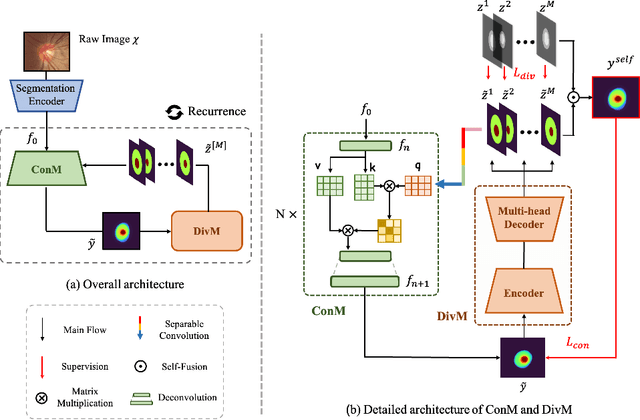


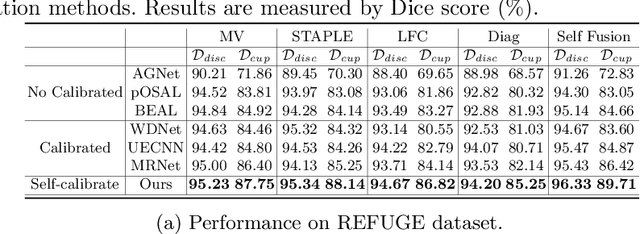
Abstract:The segmentation of optic disc(OD) and optic cup(OC) from fundus images is an important fundamental task for glaucoma diagnosis. In the clinical practice, it is often necessary to collect opinions from multiple experts to obtain the final OD/OC annotation. This clinical routine helps to mitigate the individual bias. But when data is multiply annotated, standard deep learning models will be inapplicable. In this paper, we propose a novel neural network framework to learn OD/OC segmentation from multi-rater annotations. The segmentation results are self-calibrated through the iterative optimization of multi-rater expertness estimation and calibrated OD/OC segmentation. In this way, the proposed method can realize a mutual improvement of both tasks and finally obtain a refined segmentation result. Specifically, we propose Diverging Model(DivM) and Converging Model(ConM) to process the two tasks respectively. ConM segments the raw image based on the multi-rater expertness map provided by DivM. DivM generates multi-rater expertness map from the segmentation mask provided by ConM. The experiment results show that by recurrently running ConM and DivM, the results can be self-calibrated so as to outperform a range of state-of-the-art(SOTA) multi-rater segmentation methods.
One Hyper-Initializer for All Network Architectures in Medical Image Analysis
Jun 08, 2022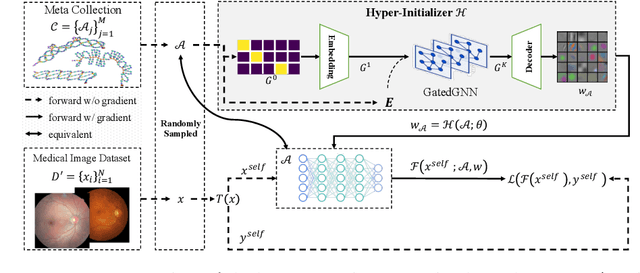
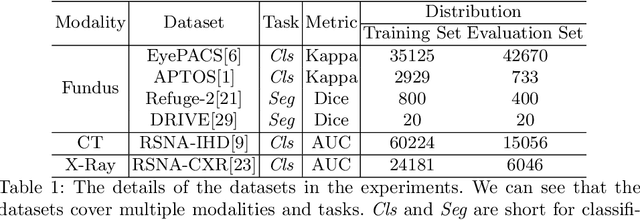

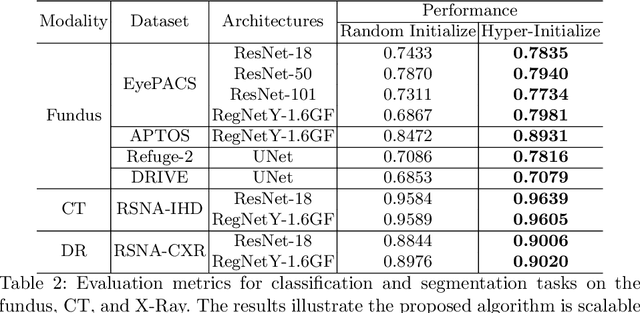
Abstract:Pre-training is essential to deep learning model performance, especially in medical image analysis tasks where limited training data are available. However, existing pre-training methods are inflexible as the pre-trained weights of one model cannot be reused by other network architectures. In this paper, we propose an architecture-irrelevant hyper-initializer, which can initialize any given network architecture well after being pre-trained for only once. The proposed initializer is a hypernetwork which takes a downstream architecture as input graphs and outputs the initialization parameters of the respective architecture. We show the effectiveness and efficiency of the hyper-initializer through extensive experimental results on multiple medical imaging modalities, especially in data-limited fields. Moreover, we prove that the proposed algorithm can be reused as a favorable plug-and-play initializer for any downstream architecture and task (both classification and segmentation) of the same modality.
An Effective Transformer-based Solution for RSNA Intracranial Hemorrhage Detection Competition
May 17, 2022



Abstract:We present an effective method for Intracranial Hemorrhage Detection (IHD) which exceeds the performance of the winner solution in RSNA-IHD competition (2019). Meanwhile, our model only takes quarter parameters and ten percent FLOPs compared to the winner's solution. The IHD task needs to predict the hemorrhage category of each slice for the input brain CT. We review the top-5 solutions for the IHD competition held by the Radiological Society of North America(RSNA) in 2019. Nearly all the top solutions rely on 2D convolutional networks and sequential models (Bidirectional GRU or LSTM) to extract intra-slice and inter-slice features, respectively. All the top solutions enhance the performance by leveraging the model ensemble, and the model number varies from 7 to 31. In the past years, since much progress has been made in the computer vision regime especially Transformer-based models, we introduce the Transformer-based techniques to extract the features in both intra-slice and inter-slice views for IHD tasks. Additionally, a semi-supervised method is embedded into our workflow to further improve the performance. The code is available in the manuscript.
Robust Collaborative Learning of Patch-level and Image-level Annotations for Diabetic Retinopathy Grading from Fundus Image
Aug 03, 2020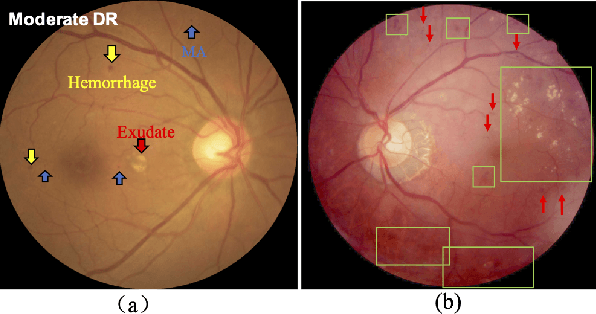

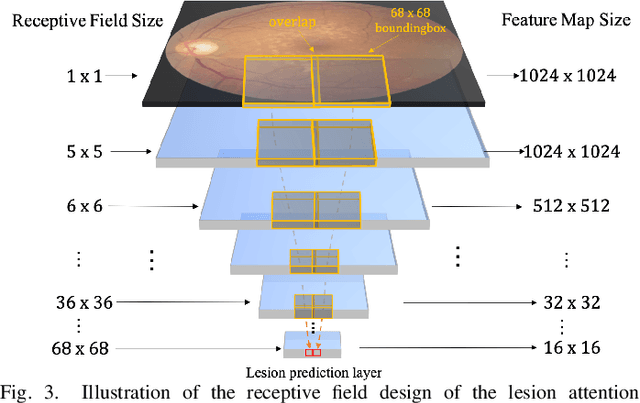
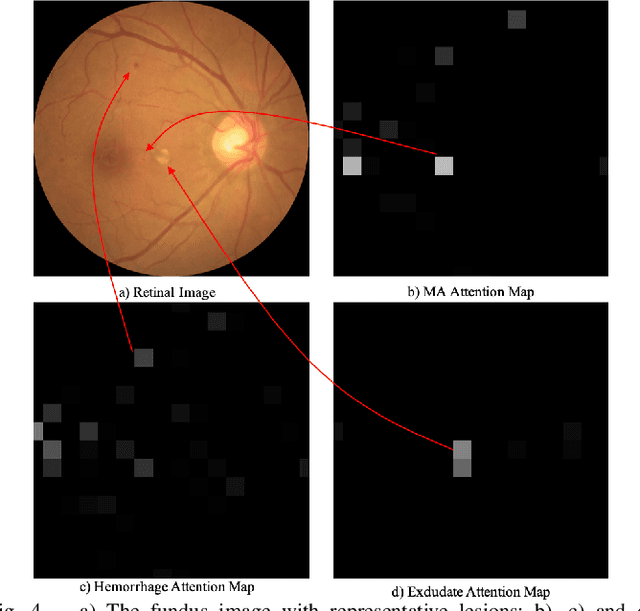
Abstract:Currently, diabetic retinopathy (DR) grading from fundus images has attracted incremental interests in both academic and industrial communities. Most convolutional neural networks (CNNs) based algorithms treat DR grading as a classification task via image-level annotations. However, they have not fully explored the valuable information from the DR-related lesions. In this paper, we present a robust framework, which can collaboratively utilize both patch-level lesion and image-level grade annotations, for DR severity grading. By end-to-end optimizing the entire framework, the fine-grained lesion and image-level grade information can be bidirectionally exchanged to exploit more discriminative features for DR grading. Compared with the recent state-of-the-art algorithms and three over 9-years clinical experienced ophthalmologists, the proposed algorithm shows favorable performance. Testing on the datasets from totally different scenarios and distributions (such as label and camera), our algorithm is proved robust in facing image quality and distribution problems that commonly exist in real-world practice. Extensive ablation studies dissect the proposed framework and indicate the effectiveness and necessity of each motivation. The code and some valuable annotations are now publicly available.
Alternating Synthetic and Real Gradients for Neural Language Modeling
Feb 27, 2019



Abstract:Training recurrent neural networks (RNNs) with backpropagation through time (BPTT) has known drawbacks such as being difficult to capture longterm dependencies in sequences. Successful alternatives to BPTT have not yet been discovered. Recently, BP with synthetic gradients by a decoupled neural interface module has been proposed to replace BPTT for training RNNs. On the other hand, it has been shown that the representations learned with synthetic and real gradients are different though they are functionally identical. In this project, we explore ways of combining synthetic and real gradients with application to neural language modeling tasks. Empirically, we demonstrate the effectiveness of alternating training with synthetic and real gradients after periodic warm restarts on language modeling tasks.
 Add to Chrome
Add to Chrome Add to Firefox
Add to Firefox Add to Edge
Add to Edge